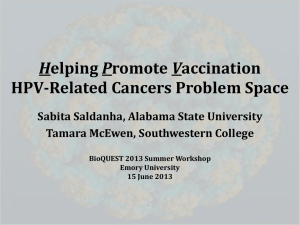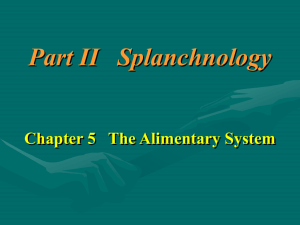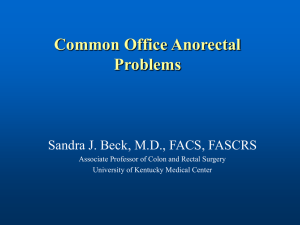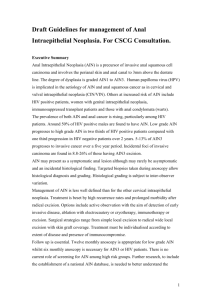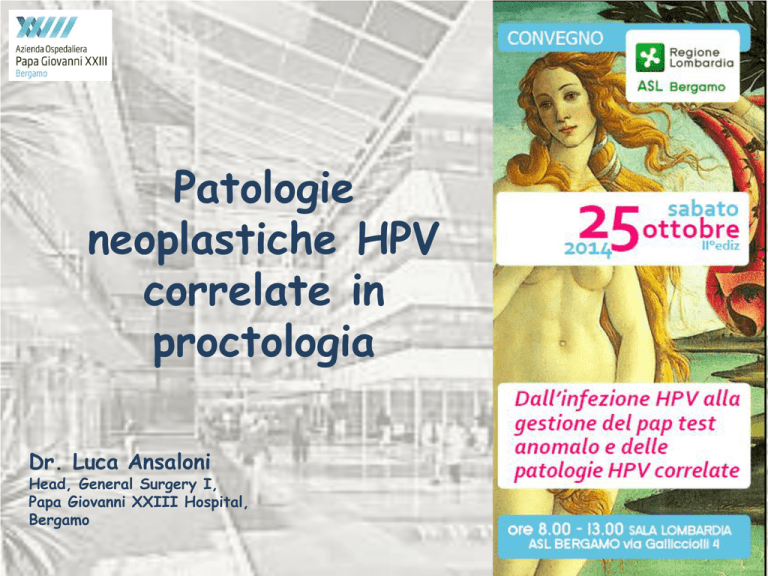
Patologie
neoplastiche HPV
correlate in
proctologia
Dr. Luca Ansaloni
Head, General Surgery I,
Papa Giovanni XXIII Hospital,
Bergamo
Incidence and risk populations for anal cancer
The incidence of anal
cancer is increasing.
In the UK: 1.5 per
100,000; in Italy: 1-3
per 100.000.
Most of this increase
is attributed to certain
at-risk populations.
human
immunodeficiency
virus (HIV)–
positive
anal squamous cell
carcinoma (ASCC)
organ transplant
recipients
Ferris DG. Vaccines for preventing HPV-related anogenital infection and
neoplasia. J Am Osteopath Assoc. 2006;106(suppl 1):S9–13.
Joseph DA et al. Understanding the burden of papillomavirus-associated
anal cancers in the US. Cancer. 2008;113(suppl 10):2892–900.
men who have
sex with men
(MSM)
women with a history of
cervical cancer, human
papilloma virus (HPV), or
cervical intraepithelial
neoplasia (CIN)
Welton ML, Varma MG. Anal cancer. In: Fleshman JW, Wolff BG eds. The ASCRS Textbook of Colon and
Rectal Surgery. New York: Springer; 2007:482–500.
Glynne-Jones R et al. Anal cancer: ESMO clinical practice guidelines for diagnosis, treatment and follow-up.
Ann Oncol.2010;21(suppl 5):v87–92.
Franceschi S, Vuyst HD. Human papillomavirus vaccines and anal carcinoma. Curr Opin HIV AIDS.
2009;4(1):57–63.
Etiology
most important risk factors for HPV and ASCC are behaviors
predisposing to HPV infection or immunosuppression.
approximately 85% of ASCC associated with HPV infection (HPV16 and HPV-18).
AIN (degree 1, 2, 3, considered analogous to CIN): potential
precursor lesion of ASCC and common among HIV-positive men
having sex with men.
HPV prevalence of AIN 1 (91.5%) and AIN 2/3 (93.9%),
respectively, among 671 and 609 pts with AIN.
Anal intercourse is among the presumed mechanisms by which
HPV is introduced into the anal canal.
Men with HIV are also at increased risk for ASCC.
Welton ML, Varma MG. Anal cancer. In: Fleshman JW, Wolff BG eds. The ASCRS Textbook of
Colon and Rectal Surgery. New York: Springer; 2007:482–500.
Bosch FX et al. Comprehensive control of HPV infections and related diseases’ vaccine volume
30, supplement 5, 2012. Comprehensive control of human papillomavirus infections and related
diseases. Vaccine. 2013;31(suppl 7):H1–31.
Goldstone S et al. Prevalence of and risk factors for human papillomavirus (HPV) infection among
HIV-seronegative men who have sex with men. J Infect Dis. 2011;203(1):66–74.
Garrett K, Kalady MF. Anal neoplasms. Surg Clin North Am. 2010;90(1):147–61.
Etiology
anal region HPV infection also becoming common in both heterosexual men
and non–HIV-infected men: prevalence of HPV DNA, detected in 222
heterosexual men, was 16.6% for the anal canal and 21.3% for the perianal
area (33.3% of these had an oncogenic high-risk HPV type).
In HIV-negative men (1305 heterosexual vs 176 homosexual), anal canal
HPV prevalence of 12.2% and 47.2%
In HIV-negative women: a prevalence of 27% anal HPV infection, but after
average F-U period of 1.3 years, 70% of women developed incident anal
HPV infection and abnormal cytology of 66.7% and 42%.
Other risk factors: increasing number of sexual partners, a history of
anogenital warts, previous lower genital tract dysplasia or ca., history of
smoking, immunosuppression in solid organ transplant and immune
disorders.
Garrett K, Kalady MF. Anal neoplasms. Surg Clin North Am. 2010;90(1):147–61.
Nyitray A et al. Prevalence of and risk factors for anal human papillomavirus infection in heterosexual men. J
Infect Dis. 2008;197:1676–84.
Nyitray AG et al. Age-specific prevalence of and risk factors for anal human papillomavirus (HPV) among men
who have sex with women and men who have sex with men: the HPV in men (HIM) study. J Infect Dis.
2011;203:49–57.
Hernandez BY et al. Anal human papillomavirus infection in women and its relationship with cervical infection.
Cancer Epidemiol Biomarkers Prev. 2005;14:2550–6.
Goodman MT et al. Acquisition of anal human papillomavirus (HPV) infection in women: the Hawaii HPV Cohort
study. J Infect Dis. 2010;201:1331–9.
Daling JR et al. Cigarette smoking and the risk of anogenital cancer. Am J Epidemiol. 1992;135(2):180–9.
Centers for Disease Control and Prevention (CDC). Cancer screening – United States, 2010. MMWR Morb
Mortal Wkly Rep. 2012;61(3):41–5.
Anatomy
4 cm
perirectal and
paravertebral
lymph nodes
inguinal and
femoral nodes
superior rectal vein drain
into the inferior mesenteric
vein and portal system
inferior rectal vein into the
pudendal vein, to the
internal iliac vein.
Marfing TE, Abel ME, Gallagher DM. Perianal Bowen’s disease and associated malignancies. Results of
a survey. Dis Colon Rectum. 1987;30(10):782–5.
Hoots BE, Palefsky JM, Pimenta JM, Smith JS. Human papillomavirus type distribution in anal cancer and
anal intraepithelial lesions. Int J Cancer. 2009;124(10):2375–83.
Clinical presentation
Bleeding: occurs in more than half of the pts with AC (usually
first sign of the disease)
Mass: Pts may present with a perianal swelling which may be wartlike or ulcerative.
Pruritis ani
Pain: ~1/3 of pts. with AC feel pain.
Change in bowel habit: tenesmus or incontinence.
Localized inguinal lymphadenopathy: with symptoms of metastatic
disease.
Welton ML, Varma MG. Anal cancer. In: Fleshman JW, Wolff BG eds. The ASCRS Textbook of Colon and Rectal
Surgery. New York: Springer; 2007:482–500.
Glynne-Jones R, Northover JMA, Cervantes A. Anal cancer: ESMO clinical practice guidelines for diagnosis, treatment
and follow-up. Ann Oncol. 2010;21(suppl 5):v87–92.
Bosch FX, Broker TR, Forman D, et al. Comprehensive control of HPV infections and related diseases’ vaccine volume
30, supplement 5, 2012. Comprehensive control of human papillomavirus infections and related diseases. Vaccine.
2013;31(suppl 7):H1–31.
Diagnosis
Physical examination: anus
inspection to look for masses,
fissures, hemorrhoids, anal
warts, or fistulas
+ digital examination
[+proctoscope, and a flexible or
rigid proctosigmoidoscope]
+ biopsy
A, B. Anal canal small cell carcinoma
(HE 20X and 200X, respectively). C.
Immunostaining for cytokeratin 2. D.
Immunostaining for synaptophysin.
SCC 47%
Transitional (cloacogenic or
synonymously known as basaloid) ca
27%
Adenoca 15%
Carcinoma, NOS 3%
Papillary villous adenoca 3%
Mucinous adenoca 2%
Melanoma 1%
Other 2%
Marfing TE et al. Perianal Bowen’s disease and associated
malignancies. Results of a survey. Dis Colon Rectum.
1987;30(10):782–5.
Staging
staging system by the American
Joint Committee on Cancer, 7th
edition, 2010 [TNM]
Stage 0: Tis, N0, M0
Stage I: T1, N0, M0
Stage II: T2 or T3, N0, M0
Stage IIIA: T1-T3, N1, M0; T4, N0, M0
Stage IIIB: T4, N1, M0; Any T, N2 or N3, M0
Stage IV: Any T, Any N, M1
Staging
computed tomography (CT) scan of
chest, abdomen, and pelvis for
assessment of the primary tumor and
for signs of metastastic disease
magnetic resonance imaging (MRI)
of the pelvis for more accurate local
staging of primary tumor
transrectal
ultrasound
Brain computed
tomography showing a
solid nodule of 15 mm
with perilesional edema
at the front left region,
and a parietal superficial
nodule of 7 mm.
three-dimensional
Positron emission tomography CT
nature
of
any
suspicious
lymphadenopathy or other possible
metastatic lesions
A. Magnetic resonance imaging which shows an irregularity of the right posterolateral
wall of the anal canal about 3 cm above the levator ani muscle. B. Lateral lymph node
located right above the level of tumor.
Management
from radical surgery to primary
chemoradiotherapy, resulting in
reduced permanent colostomy rates
+
Otherwise, radical surgery is
recommended to improve local
control.
For all 4 stages of
ASCC except for small
T1 tumors of the anal
margin, concurrent
chemo and
radiotherapy are
recommended over
radiotherapy alone.
+
Chemoradiotherapy
Radiotherapy is given to the tumor and inguinal nodes.
Radiation therapy alone may lead to a 5-year survival rate in
excess of 70% [excellent outcomes especially for pts with T1,
N0, and M0 disease with radiation alone].
After ACT II trial, radiotherapy (50.4 Gy in 28 fractions in two
phases) accompanied by administration of mitomycin and 5fluorouracil (5-FU) is now standard treatment for ASCC. Other
regimens in American and European centers (prescription dose
can range from 54 to 59 Gy in varying schedules).
effectiveness of chemotherapy concurrent with intense modulated
radiotherapy: colostomy-free survival with local control rates of
83.7% and 83.9%, as well as a favorable toxicity profile.
Northover JMA et al. Epidermoid anal cancer: results from the UKCCCR randomised trial of radiotherapy alone
versus radiotherapy, 5-fluorouracil, and mitomycin. UKCCCR Anal Cancer Trial Working Party. UK Coordinating Committee on Cancer Research. Lancet. 1996;348(9034):1049–54.
Berger B et al. Postoperative versus definitive chemoradiation in early-stage anal cancer. Results of a matchedpair analysis. Strahlenther Onkol. 2012;188(7):558–63.
Bradner WT. Mitomycin C: a clinical update. Cancer Treat Rev. 2001;27(1):
35–50.
Gilbert DC, Glynne-Jones R. Intensity-modulated radiotherapy in anal cancer – where do we go from here? Clin
Oncol. 2013;25(3):153–4.
Chemoradiotherapy
+
TOXICITIES
EARLY
Although about 60–90% of
sphincter preservation
preserves QOL, acute grade
3–4 toxicities occur, mainly
consisting of skin reactions,
diarrhea, and those that
are caused by
chemotherapy, ie, nausea,
vomiting, mucositis,
neutropenia, and infection.
LATE
are not insignificant and can
greatly impinge upon pt QOL.
Symptoms include chronic diarrhea,
dysuria, chronic pelvic pain,
fractures, and sexual dysfunction.
Overall, complications of anal canal
occur in 15–13% of pts and include
anal ulcers, anal stenosis and
necrosis, fistulae, and anal
incontinence.
Subhashis M, Lawrence C. Diagnosis, treatment, and prevention of anal cancer. Curr Infect Dis Rep.
2011;14(1):61–6.
Surgery
The indications for surgery:
1. Persisting tumor after chemoradiotherapy,
2. Recurrent tumor after previous radiotherapy, and
3. Small T1 anal margin tumors without sphincter involvement.
standard salvage therapy for 1 and 2 groups,
following
chemoradiotherapy,
has
been
abdominoperineal resection (APR).
The vagina may need to be excised en bloc when
involved, and a plastic surgeon will be required to
close large defects in flaps such as the vertical
rectus abdominis myocutaneous and the inferior
gluteal artery perforator.
APR can achieve local control in 50–60% of
patients, provided that a curative resection can be
obtained. In cases involving inguinal lymph nodes, a
radical groin dissection should be considered.
ASCC
Hainsworth A, Al Akash M, Roblin P, Mohanna P, Ross D, George ML. Perineal reconstruction after
abdominoperineal excision using inferior gluteal artery perforator flaps. Br J Surg. 2012;99(4):584–8.
Surgery
1884 and 1906
Surgery
Surgery for T1 lesions (group 3) remains
uncertain primarily because of the inability to
achieve ideal characteristics in all pts.
Specifically, the relatively high degree of
failure in achieving appropriate clear
margins is disappointing and may account for
a significant number of local failures.
However, local excision seems to be a viable
option in well-selected pts (ie, those with welldifferentiated or moderately well-differentiated T1
cancers involving ,40% of the circumference, without
lymphovascular invasion), particularly when the only
other option is APR.
Subhashis M, Lawrence C. Diagnosis, treatment, and prevention of anal cancer. Curr Infect Dis Rep.
2011;14(1):61–6.
Wietfeldt ED, Thiele J. Malignancies of the anal margin and perianal skin. Clin Colon Rectal Surg.
2009;22(2):127–35.
Scholefield JH, Castle MT, Watson NF. Malignant transformation of high-grade anal intraepithelial neoplasia.
Br J Surg. 2005;92:1133–6.
Other local treatments
mainly used for premalignant lesions such as AIN and Bowen’s disease, but
described even for invasive ASCC for small lesions (<1 cm2) in the perianal or
intra-anal regions, including:
imiquimod 5% cream (an immune modulator)
bichloroacetic or trichloroacetic acid
topical 5-FU
Limited data are available comparing different
photodynamic therapy
treatment modalities in men with high-grade
CO2 laser therapy
AIN. one RCT that studied 148 men assigned
to imiquimod, topical 5-FU, or electrocautery.
electrocautery ablation
the complete response rates with imiquimod,
5-FU, and electrocautery were 24%, 17%, and
39%, respectively
Peris K et al.. Imiquimod 5% cream in the treatment of Bowen’s disease and invasive squamous cell carcinoma. J Am Acad
Dermatol. 2006;l55:324–7.
Fox PA et al. A double-blind, randomized controlled trial of the use of imiquimod cream for the treatment of anal canal highgrade anal intraepithelial neoplasia in HIV-positive MSM on HAART, with long-term follow-up data including the use of openlabel imiquimod. AIDS. 2010;24(15):2331.
Kreuter A et al. German competence network HIV/AIDS. Imiquimod leads to a decrease of human papillomavirus DNA and to
a sustained clearance of anal intraepithelial neoplasia in HIV-infected men. J Invest Dermatol. 2008;128(8):2078.
Singh JC et al.. Efficacy of trichloroacetic acid in the treatment of anal intraepithelial neoplasia in HIV-positive and HIVnegative men who have sex with men. J Acquir Immune Defic Syndr. 2009;52(4):474.
Allison RR et al. Photodynamic therapy for anal cancer. Photodiagnosis Photodyn Ther. 2010;7(2):115–9.
Watemberg S et al.. Successful treatment of anal tumors with CO2 laser in elderly, high-risk patients. J Clin Laser Med Surg.
1996;14(3):115–7.
Pineda CE et al. High-resolution anoscopy targeted surgical destruction of anal high-grade squamous intraepithelial lesions: a
ten-year experience. Dis Colon Rectum. 2008;51(6):829.
Marks DK. Electrocautery ablation of high-grade anal squamous intraepithelial lesions in HIV-negative and HIV-positive men
who have sex with men. J Acquir Immune Defic Syndr. 2012;59(3):259–65..
Screening and detection
At present, there are no national
guidelines for routine screening for anal
cancer. As the risk factors for anal
cancers are known, screening patients
for AIN using anal swabs and
Papanicolaou test at least in high-risk
groups may be a potential screening
method.
As the pathophysiological
characteristics of anal cancer are
similar to those of other intraepithelial
neoplasms found on the cervix, penis,
oral tissue, and vulva, the grading and
results of anal pap tests uses the
Bethesda 2001 system46 categorizing
cervical disease in increasing order of
severity.
Prevention
o Encouraging good behavioral interventions, such as cigarette smoke
and limiting sexual partners, would likely affect HPV transmission.
Practicing safer sex, such as by increased condom use, may also be
effective in reducing HPV transmission.
o Male circumcision has also been effective at reducing the risk of
transmission of HPV and cervical cancer.
o preventing and therapeutic vaccinations against HPV infection.
Scott-Sheldon L et al. Efficacy of behavioural interventions to increase condom use and reduce
sexually transmitted infections: a meta-analysis, 1991 to 2010. J Acquir Immune Defic Syndr.
2011;58:489–98.
49. Watson RA. Human papillomavirus: confronting the epidemic – a urologist’s perspective.
Rev Urol. 2005;7(3):135–44.
50. FUTURE I/II Study Group, Dillner J, Kjaer SK, et al. Four year efficacy of prophylactic
human papillomavirus quadrivalent vaccine against low grade cervical, vulvar, and vaginal
intraepithelial neoplasia and anogenital warts: randomised controlled trial. BMJ.
2010;341:c3493.
51. James RD, et al. Mitomycin or cisplatin chemoradiation with or without maintenance
chemotherapy for treatment of squamous-cell carcinoma of the anus (ACT II): a randomised,
phase 3, open-label, 2 × 2 factorial trial. Lancet Oncol. 2013;14(6):516–24.
…and colorectal canver?
lansaloni@hpg23.it
GRAZIE
Outcomes:
•
•
•
•
•
Morbidity
Mortality
Post-operative leghth of stay
Operating time
Intraoperative Haemorrage > 500 ml
Cosa è l’HIPEC?
Luca Ansaloni, M.D.
Chief of General Surgery I
Papa Giovanni XXIII Hospital
Bergamo, Italy
Bergamo, 20 Febbraio 2014
lansaloni@hpg23.it






